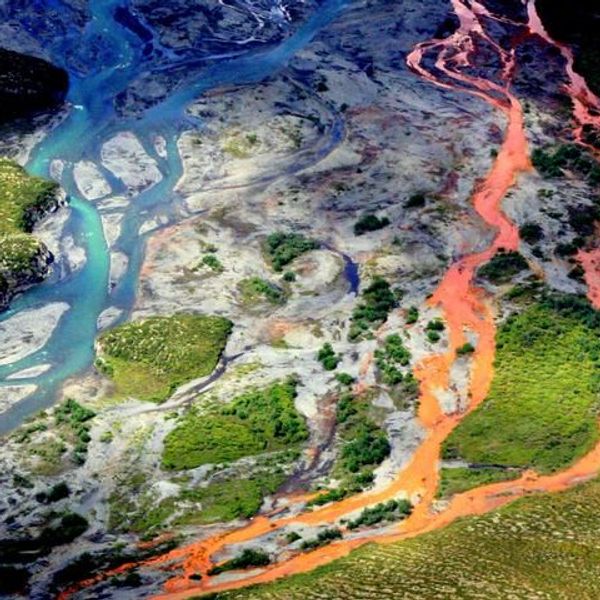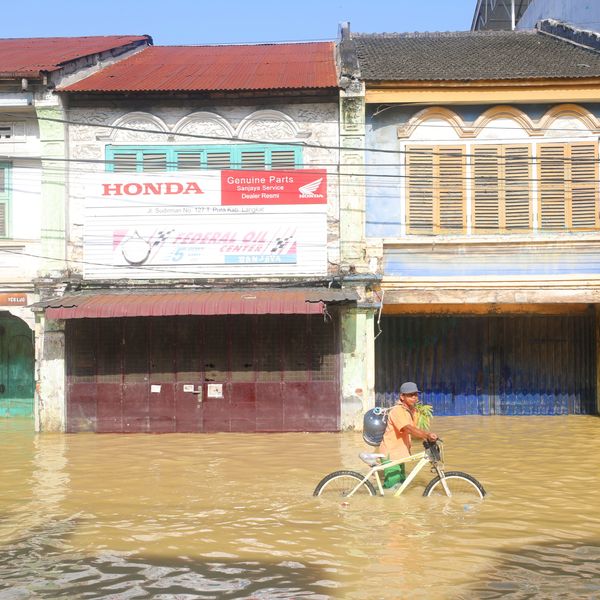Unprecedented Warming in Antarctica Causes Worst Melting in 1,000 Years
Antarctic Peninsula ice loss 10 times more than it was 600 years ago
Ice is melting at a faster rate in the Antarctic Peninsula than at any time in the past 1000 years, and ten times more than it was 600 years ago, according to a new study by the Australian National University and the British Antarctic Survey, published in Nature Geoscience.
According to lead researcher Dr Nerilie Abram:
This new ice core record shows that even small changes in temperature can result in large increases in the amount of melting in places where summer temperatures are near to zero. This has important implications for ice stability and sea level rise in a warming climate.
As Al Jazeera reports Sunday, temperatures across the Antarctic Peninsula, the region focused upon in the study, have risen sharply specifically over the past fifty years, "making this the most rapidly warming region in the Southern Hemisphere."
Abram stated:
Summer melting at the ice-core site today is now at a higher level than at any other time over at least the last 1000 years. And whilst temperatures at this site increased gradually in phases over many hundreds of years, most of the intensification of melting has happened since the mid-20th Century.
Warming in the Antarctic Peninsula comes to over five times the global average and is comparable to rapidly warming regions of the Arctic.
Steff Gaulter at Al Jazeera reports that "around 25,000 km2 of ice have been lost from ten floating ice shelves on the Antarctic Peninsula. This is particularly significant as it takes a long time to replenish snow and ice in this part of the world."
It is widely held that Antarctica is not at risk of dangerous melting because it often replenishes its ice loss and tends to expand in size. However, according to the study, the rate of ice that is lost on the Antarctic Peninsula region now far exceeds that which is replenished each year.
Gaulter adds: "The global significance of this is difficult to assess. However, the warming of the Antarctic Peninsula is amongst the highest seen anywhere on Earth in recent times, and is a reminder of the rationality of climate change that can be expected in the future."
_______________________
An Urgent Message From Our Co-Founder
Dear Common Dreams reader, The U.S. is on a fast track to authoritarianism like nothing I've ever seen. Meanwhile, corporate news outlets are utterly capitulating to Trump, twisting their coverage to avoid drawing his ire while lining up to stuff cash in his pockets. That's why I believe that Common Dreams is doing the best and most consequential reporting that we've ever done. Our small but mighty team is a progressive reporting powerhouse, covering the news every day that the corporate media never will. Our mission has always been simple: To inform. To inspire. And to ignite change for the common good. Now here's the key piece that I want all our readers to understand: None of this would be possible without your financial support. That's not just some fundraising cliche. It's the absolute and literal truth. We don't accept corporate advertising and never will. We don't have a paywall because we don't think people should be blocked from critical news based on their ability to pay. Everything we do is funded by the donations of readers like you. Will you donate now to help power the nonprofit, independent reporting of Common Dreams? Thank you for being a vital member of our community. Together, we can keep independent journalism alive when it’s needed most. - Craig Brown, Co-founder |
Jacob Chamberlain is a former staff writer for Common Dreams. He is the author of Migrant Justice in the Age of Removal. His website is www.jacobpchamberlain.com.
Ice is melting at a faster rate in the Antarctic Peninsula than at any time in the past 1000 years, and ten times more than it was 600 years ago, according to a new study by the Australian National University and the British Antarctic Survey, published in Nature Geoscience.
According to lead researcher Dr Nerilie Abram:
This new ice core record shows that even small changes in temperature can result in large increases in the amount of melting in places where summer temperatures are near to zero. This has important implications for ice stability and sea level rise in a warming climate.
As Al Jazeera reports Sunday, temperatures across the Antarctic Peninsula, the region focused upon in the study, have risen sharply specifically over the past fifty years, "making this the most rapidly warming region in the Southern Hemisphere."
Abram stated:
Summer melting at the ice-core site today is now at a higher level than at any other time over at least the last 1000 years. And whilst temperatures at this site increased gradually in phases over many hundreds of years, most of the intensification of melting has happened since the mid-20th Century.
Warming in the Antarctic Peninsula comes to over five times the global average and is comparable to rapidly warming regions of the Arctic.
Steff Gaulter at Al Jazeera reports that "around 25,000 km2 of ice have been lost from ten floating ice shelves on the Antarctic Peninsula. This is particularly significant as it takes a long time to replenish snow and ice in this part of the world."
It is widely held that Antarctica is not at risk of dangerous melting because it often replenishes its ice loss and tends to expand in size. However, according to the study, the rate of ice that is lost on the Antarctic Peninsula region now far exceeds that which is replenished each year.
Gaulter adds: "The global significance of this is difficult to assess. However, the warming of the Antarctic Peninsula is amongst the highest seen anywhere on Earth in recent times, and is a reminder of the rationality of climate change that can be expected in the future."
_______________________
Jacob Chamberlain is a former staff writer for Common Dreams. He is the author of Migrant Justice in the Age of Removal. His website is www.jacobpchamberlain.com.
Ice is melting at a faster rate in the Antarctic Peninsula than at any time in the past 1000 years, and ten times more than it was 600 years ago, according to a new study by the Australian National University and the British Antarctic Survey, published in Nature Geoscience.
According to lead researcher Dr Nerilie Abram:
This new ice core record shows that even small changes in temperature can result in large increases in the amount of melting in places where summer temperatures are near to zero. This has important implications for ice stability and sea level rise in a warming climate.
As Al Jazeera reports Sunday, temperatures across the Antarctic Peninsula, the region focused upon in the study, have risen sharply specifically over the past fifty years, "making this the most rapidly warming region in the Southern Hemisphere."
Abram stated:
Summer melting at the ice-core site today is now at a higher level than at any other time over at least the last 1000 years. And whilst temperatures at this site increased gradually in phases over many hundreds of years, most of the intensification of melting has happened since the mid-20th Century.
Warming in the Antarctic Peninsula comes to over five times the global average and is comparable to rapidly warming regions of the Arctic.
Steff Gaulter at Al Jazeera reports that "around 25,000 km2 of ice have been lost from ten floating ice shelves on the Antarctic Peninsula. This is particularly significant as it takes a long time to replenish snow and ice in this part of the world."
It is widely held that Antarctica is not at risk of dangerous melting because it often replenishes its ice loss and tends to expand in size. However, according to the study, the rate of ice that is lost on the Antarctic Peninsula region now far exceeds that which is replenished each year.
Gaulter adds: "The global significance of this is difficult to assess. However, the warming of the Antarctic Peninsula is amongst the highest seen anywhere on Earth in recent times, and is a reminder of the rationality of climate change that can be expected in the future."
_______________________

